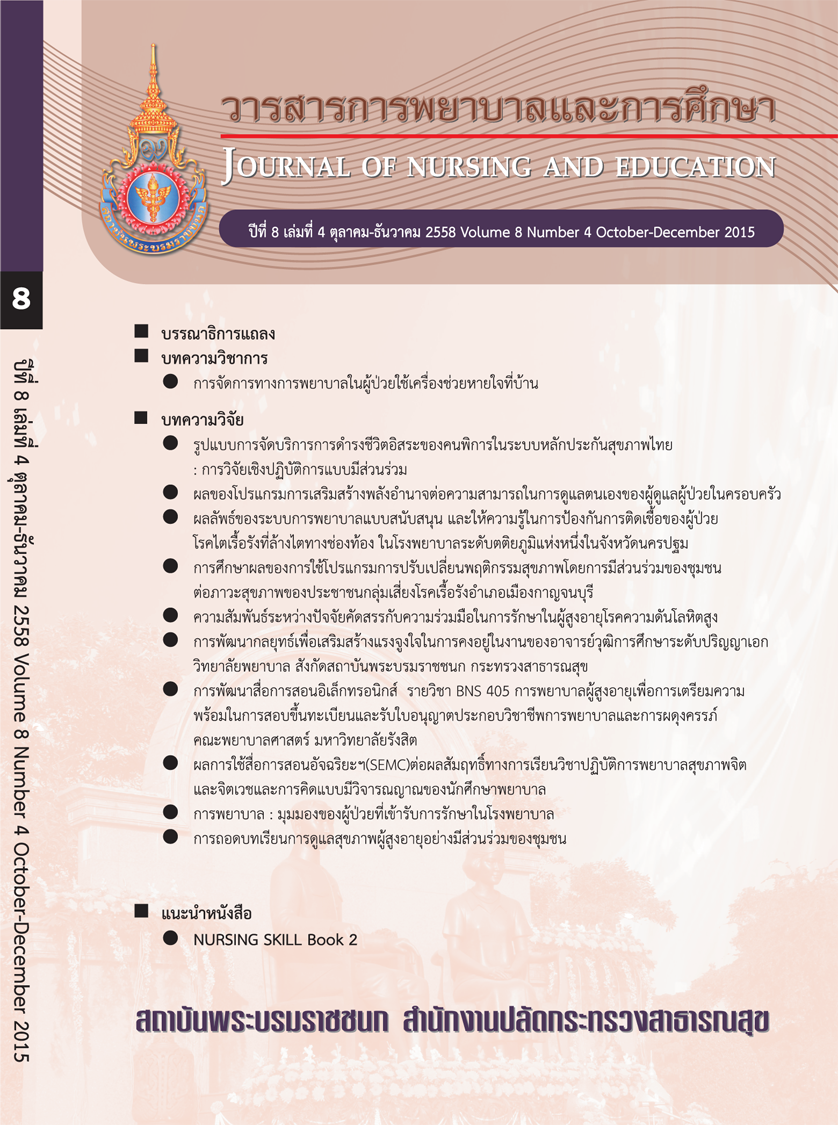ความสัมพันธ์ระหว่างปัจจัยคัดสรรกับความร่วมมือในการรักษาในผู้สูงอายุโรคความดันโลหิตสูง
คำสำคัญ:
ความร่วมมือในการรักษา, ผู้สูงอายุ, ความดันโลหิตสูง, Adherence to Therapeutic Regimens, Older Adults, Hypertensionบทคัดย่อ
บทคัดย่อ
ความร่วมมือในการรักษาในผู้สูงอายุโรคความดันโลหิตสูงมีความจำเป็นในการควบคุมความ
ดันโลหิตให้อยู่ในระดับที่เหมาะสม การทราบเกี่ยวกับปัจจัยคัดสรรกับความร่วมมือในการรักษามีความจำเป็นในการส่งเสริมความร่วมมือในการรักษา การศึกษาครั้งนี้มีวัตถุประสงค์เพื่อศึกษาความสัมพันธ์ระหว่างปัจจัยคัดสรร ได้แก่ ปัจจัยการทำหน้าที่ด้านสติปัญญา การทำหน้าที่ด้านร่างกาย การติดต่อสื่อสารระหว่างบุคลากรสุขภาพและผู้ป่วย ความรู้เกี่ยวกับความดันโลหิตสูง ความเชื่อด้านสุขภาพ การสนับสนุนทางสังคมของครอบครัว และการรับรู้สมรรถนะแห่งตนในความร่วมมือในการรักษา กับความร่วมมือ
ในการรักษาในผู้สูงอายุโรคความดันโลหิตสูง
กลุ่มตัวอย่าง ได้แก่ ผู้ที่มีอายุตั้งแต่ 60 ปีขึ้นไป จำนวน 341 ราย ที่มารับการตรวจที่คลินิก
โรคความดันโลหิตสูงในโรงพยาบาลชุมชน 5 แห่งของจังหวัดพะเยา ได้รับการวินิจฉัยว่าเป็นโรคความดันโลหิตสูงอย่างน้อย 6 เดือนขึ้นไป และรับประทานยาลดความดันโลหิตอย่างน้อย 1 ชนิด เก็บข้อมูลโดยใช้แบบสอบถามที่มีค่าความเชื่อมั่น โดยมีค่าสัมประสิทธิ์แอลฟ่าของครอนบาค อยู่ระหว่าง .799 ถึง .847 วิเคราะห์ข้อมูลโดยใช้สถิติเชิงพรรณนาและค่าสหสัมพันธ์ของเพียร์สัน
ผลการศึกษา พบว่า การรับรู้สมรรถนะแห่งตนในความร่วมมือในการรักษา การรับรู้ความเสี่ยง
การรับรู้ความรุนแรง การรับรู้ประโยชน์ การสื่อสารระหว่างบุคลากรสุขภาพกับผู้ป่วย และการสนับสนุนทางสังคมจากครอบครัว มีความสัมพันธ์ทางบวกกับความร่วมมือในการรักษา (p < .01) ส่วนการทำหน้าที่ด้านสติปัญญา มีความสัมพันธ์ทางลบกับความร่วมมือในการรักษา (p < .05) ในขณะที่การทำหน้าที่ด้านร่างกาย ความรู้เกี่ยวกับโรคความดันโลหิตสูง และการรับรู้อุปสรรค ไม่มีความสัมพันธ์กับความร่วมมือในการรักษา โดยจากผลการศึกษาสามารถนำปัจจัยคัดสรรดังกล่าวไปใช้เป็นแนวทางในการส่งเสริมความร่วมมือในการรักษาในผู้สูงอายุโรคความดันโลหิตสูงต่อไป
คำสำคัญ : ความร่วมมือในการรักษา ผู้สูงอายุ ความดันโลหิตสูง
Abstract
Adherence to therapeutic regimens among older adults with hypertension is
necessary for controlling appropriate blood pressure in older people. Knowing regarding selected factors is necessary for enhancing adherence to therapeutic regimens.
The aim of the study was to study relationships between selected factors,
including cognitive function, physical function, patient-provider communication, knowledge of hypertension, health belief, social support from family and perceived self-efficacy to adherence and adherence to therapeutic regimens among older people with hypertension. Simple random sampling was used to obtain 341 samples attending five hypertension clinics in community hospital in Phayao. Also, diagnosed with hypertension for at least 6 months, being Thai older people with hypertension aged ≥ 60 years and taking antihypertensive drug at least one type. Data collection used acceptable questionnaires which had the Alpha Cronbach’s coefficient between .799 to .847. Descriptive and Pearson product-moment correlation coefficient were used to analyze all data.
Results showed that perceived self-efficacy to adherence perceived susceptibility perceived severity perceived benefits provider-patient communication and social support from family had a positive relationship with adherence to therapeutic regimens (p < .01). Also, cognitive function had a negative relationship with adherence to therapeutic regimens (p < .05). Whereas, physical function, knowledge of hypertension and perceived barriers was no significant statistically relationship with adherence to therapeutic regimens. These selected factors can be developed program for enhancement of adherence to therapeutic regimens among older adults with hypertension.
Keywords : Adherence to Therapeutic Regimens, Older Adults,
Hypertension






